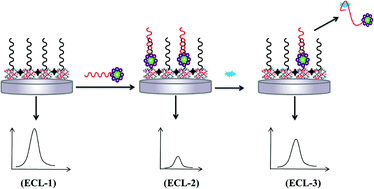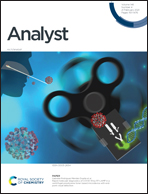A novel signal amplified electrochemiluminescence biosensor based on MIL-53(Al)@CdS QDs and SiO2@AuNPs for trichlorfon detection
Abstract
An ultrasensitive electrochemiluminescence (ECL) biosensor was developed based on MIL-53(Al)@CdS QDs and SiO2@AuNPs for trichlorfon detection. Metal–organic frameworks (MOFs) were used as a loading platform that provided a large surface area to load targets and modified materials onto the electrode. At the same time, SiO2@AuNPs loaded plenty of AuNPs which effectively increased the ECL resonance energy transfer between the CdS QDs, so that the ECL signal was strongly quenched and resulted in an amplified response. In the range of 10−11–10−4 M, the ECL response showed a linear relationship with the concentration (logarithm) of trichlorfon, and the detection limit was 5.1 × 10−12 M (S/N = 3). When the biosensor was applied to detect trichlorfon in lettuce, broccoli, cucumber, and chives, the recoveries obtained from the spiked samples were 97%–105%, 102%–104%, 100%–104%, and 98%–104%, respectively. Thus, this novel ECL biosensor has potential applications for the analysis of trichlorfon in food samples.



 Please wait while we load your content...
Please wait while we load your content...